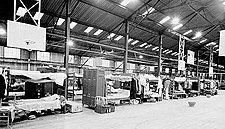Capacity N/A Closed 1938 Demolished 1977 | Broke ground 1921 Opened 1924 Construction cost 54,482.4 USD | |
 | ||
Location South Road, Chapel Hill, N.C., United States (demolished) Field size 300 × 110 feet (91 × 34 m) Architect Bard-Knox Company, Pittsburgh, Pa., United States Owner University of North Carolina at Chapel Hill Similar Bynum Gymnasium, Woollen Gymnasium, Henry Stadium, Eddie Smith Field House, Davie Poplar | ||
Officially named the Indoor Athletic Center (or Court), the Tin Can was the home of North Carolina Tar Heels men's basketball from the 1924 season until the team's relocation to the Woollen Gymnasium in 1938. It replaced Bynum Gymnasium, a venue known for its unusual running track suspended above the court.
Rudimentarily built of steel, attempts to heat the building during early season at first failed, with ice often forming inside:
The team, known as the White Phantoms, used this to their advantage, becoming one of the South's most successful programs by the mid-1920s.
As success continued into Southern Conference play in the 1930s, the capacity of the Tin Can proved insufficient to meet the increased interest in the team. North Carolina played the last of their games there at the end of the 1938 season, having officially moved to the adjacent Woollen Gymnasium on January 4, 1938. In fourteen years, the team had accumulated a 120–38 winning record.
No longer needed for major athletic events the Tin Can was used for a variety of purposes during the remainder of its life. Immediately after World War II, the arena housed returning veterans due to a shortage of dormitory space, while in the early 1950s it was used for storage of medical equipment before the completion of North Carolina Memorial Hospital. After hosting a limited number of indoor track meetings in preceding years, the Tin Can was finally demolished in 1977 to allow the construction of the present day Fetzer Gymnasium.
